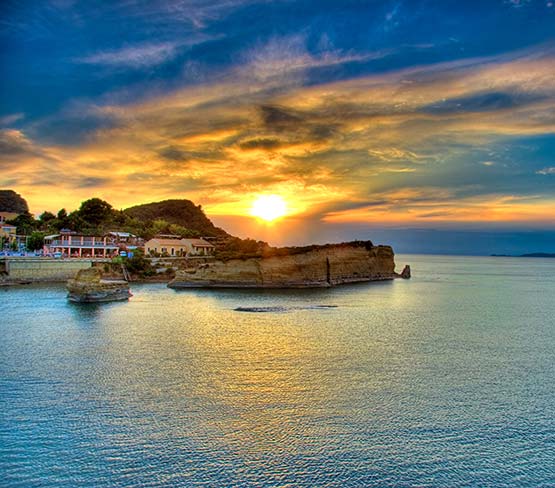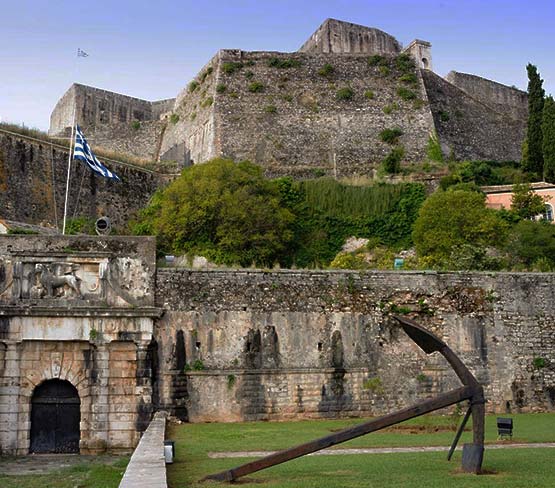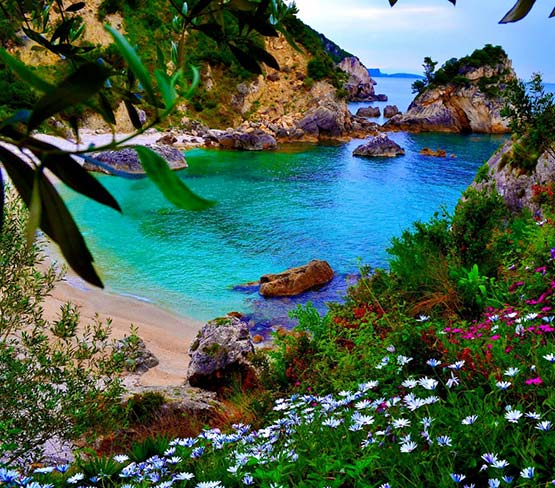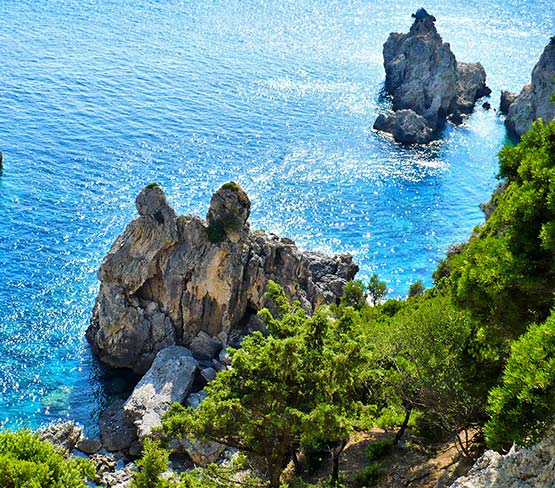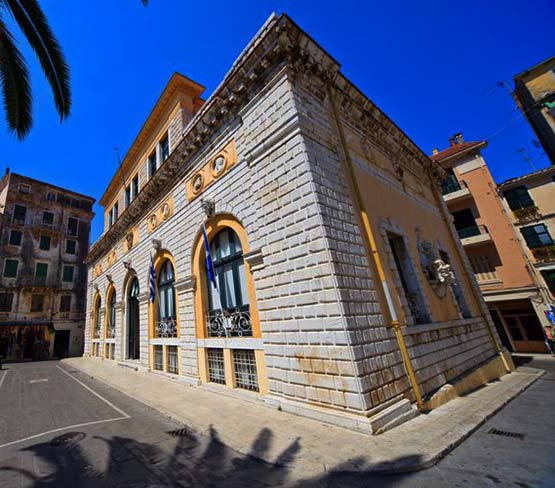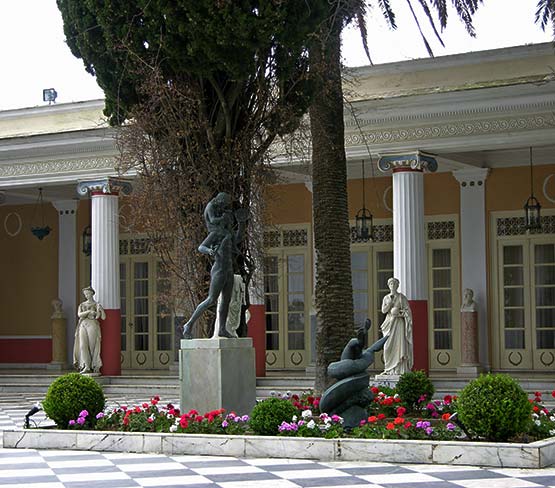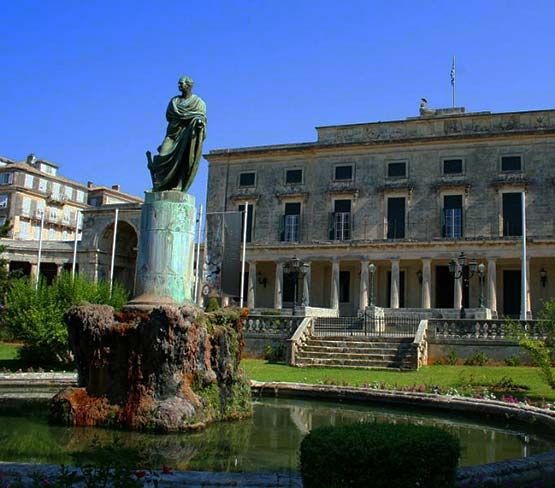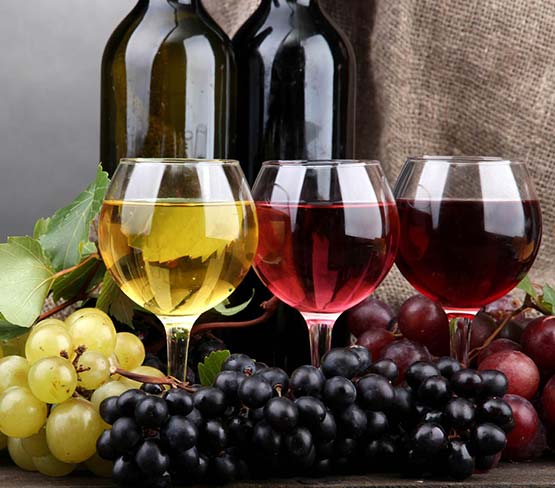Corfu Ipsos Apartments
Corfu Mythology
Corfu is a Greek island in the Ionian Sea. It is the second largest of the Ionian Islands, and, including its small satellite islands, forms the edge of the northwestern frontier of Greece.The island is bound with the history of Greece from the beginning of Greek mythology. Its Greek name, Kerkyra or Korkyra, is related to two powerful water symbols: Poseidon, god of the sea, and Asopos, an important Greek mainland river.
According to myth, Poseidon fell in love with the beautiful nymph Korkyra, daughter of Asopus and river nymph Metope, and abducted her. Poseidon brought Korkyra to the hitherto unnamed island and, in marital bliss, offered her name to the place: Korkyra, which gradually evolved to Kerkyra (Doric). Together, they had a child they called Phaiax, after whom the inhabitants of the island were named: Phaiakes. This term was transliterated via Latin to Phaeacians.
Corfu History
The island’s history is laden with battles and conquests. The legacy of these struggles is visible in the form of castles punctuating strategic locations across the island. Two of these castles enclose its capital, which is the only city in Greece to be surrounded in such a way. As a result, Corfu’s capital has been officially declared a Kastropolis (“castle city”) by the Greek government.
Corfu was long controlled by Venice, which repulsed several Turkish sieges, before falling under British rule following the Napoleonic Wars. Corfu was eventually ceded by the British Empire along with the remaining islands of the United States of the Ionian Islands, and unification with modern Greece was concluded in 1864 under the Treaty of London.
In 2007, the city’s old city was designated for the UNESCO World Heritage List.
Corfu is a very popular tourist destination. Up until the early 20th century, it was mainly visited by the European royals and elites, including Emperor Wilhelm II of Germany and Empress Elisabeth of Austria; today it is also widely visited by middle class families (primarily from the UK, Scandinavia and Germany), leading to mass tourism. It is still popular with the global elite however, and in the island’s northeast the homeowners include members of the Rothschild family and Russian oligarchs.
The island of Corfu was one of the first islands in Greece to open itself to tourism and has everything to offer to the visitor. The island attracts thousands of visitors every year from all parts of the world. The island of Corfu is part of the Ionian Islands and lies in the north of the group, at the entrance of the Adriatic Sea, facing Albania. It is the second largest island of the Ionian group after Kefalonia. Corfu has a total area of 592 square kilometres, a coastline of 216 kilometres. The island’s population consists of 100,000 inhabitants from which 30,000 is gathered in the capital of the island, Corfu Town (or Kerkyra).
Because of the mild Mediterranean climate and the high rainfalls during winter, Corfu is full of abundant and verdant vegetation and wild plants, phenomenon that makes it one of the greenest islands in Greece. The island is mountainous and its northern centre lays Mount Pantokrator, the highest mountain of Corfu, which rises to an altitude of 914 metres. Several flat areas, plains, two lakes and a couple of rivers complete the beautiful landscape.
Corfu was the first island to welcome and open its doors to tourism and has since become an important international tourism centre attracting many visitors and offering well-equipped and modern touristy facilities. Despite the fact that tourism is flagrant in the coastal areas, it hasn’t spoilt yet the villages that have managed to keep their authenticity and their local colours.
The economy of Corfu is mainly based on tourism but a small part is still related to the agriculture, the inhabitants still producing high quality olive oil and wines throughout the mountainous villages. The capital of the island is called Corfu Town and is also the main port; it is the largest town of the Ionians and one of the most beautiful towns of the Greek islands. Built between two fortresses and full of superb Italian and French buildings, Byzantine churches and flowered squares, Corfu Town is a real jewel full of innumerable charms and beauties.
Corfu’s natural beauty hasn’t gone unnoticed by the film industry it has been the setting for several movies. On the north of Corfu, there are three small islands, untouched by tourism and great for total privacy: they are the Diapontia islands, that are Othoni, Mathraki and Ereikoussa. They can be reached by boat from Agios Stefanos or Sidari.
An Architectural Overview
Corfu contains a few very important remains of antiquity. The site of the ancient city of Corcyra (Kerkyra) is well ascertained, about 1.5 miles (2 km) to the south-east of Corfu, upon the narrow piece of ground between the sea-lake of Halikiopoulo and the Bay of Castrades, in each of which it had a port. The circular tomb of Menekrates, with its well-known inscription, is on the Bay of Castrades. Under the hill of Ascension are the remains of a temple, popularly called of Poseidon, a very simple dome structure, which still in its mutilated state presents some peculiarities of architecture.
In regard of Cassiope, the only other city of ancient importance, its name is still preserved by the village of Cassiopi, and there are some rude remains of building on the site; but the temple of Zeus Cassius for which it was celebrated has totally disappeared. Throughout the island numerous monasteries and other buildings of Venetian erection are to be found, of which the best known are Paleokastritsa, San Salvador and Peleka. The Achilleion is a palace commissioned by Elisabeth of Austria and purchased in 1907 by Wilhelm II of Germany; it is now a popular tourist attraction.
Italianate Architecture
Corfu city is famous for its Italianate architecture, most notably the Liston (it) an arched colonnade lined with cafes on the edge of the Spianada (Esplanade), the vast main plaza and park which incorporates a cricket field and several pavilions. Also notable are the Venetian-Roman style City Hall, the Old and New castles, the recently restored Palace of Sts. Michael and George, formerly the residence of the British governor and the seat of the Ionian Senate, and the summer Palace of Mon Repos, formerly the property of the Greek royal family and birthplace of the Duke of Edinburgh.
The Park of Mon Repos is adjacent to the Palaiopolis of Kerkyra, where excavations were conducted by the Greek Archaeological Service in collaboration with the University of Louvain-la-Neuve in Belgium, and Brown University in the United States. Examples of the finds can be found in the Museum of the Palace of Mon Repos.
Destructions of Architecture brought about by World War II
During World War II, the island was bombed by the German airforce, resulting in the destruction of most of the city’s buildings, including its market (αγορά) and Hotel Bella Venezia. The worst architectural losses of the Luftwaffe bombardment were the splendid buildings of the Ionian Academy (Ιόνιος Ακαδημία), and the Municipal Theatre (which in 1901 had replaced the Nobile Teatro di San Giacomo).
The Roman style Theatre (Θέατρον) of the city was later replaced by a bland, modern box-style building. Discussions have been held at local governmental level about demolishing this modern building and replacing it with a replica of the old theatre. In contrast, the Ionian University reconstructed the Ionian Academy in all its former glory.
Achilleion Corfu
Empress of Austria Elisabeth of Bavaria, also known as Sissi, was a woman entranced by beauty. She lost her only son, Crown Prince Rudolf of Austria, when he committed murder-suicide in The Mayerling Incident of 1889. A year later, in 1890, she built a summer palace in the region of Gastouri to the south of the city, with the powerful mythical hero Achilles as its central theme. The palace, with the neoclassical Greek statues that surround it, is a monument to platonic romanticism as well as escapism.
It was named Achílleion after the Homeric hero Achilles. The structure is filled with paintings and statues of Achilles, both in the main hall and in the gardens, depicting the scenes of the Trojan War. The Imperial gardens on the hill look over the surrounding green hill crests and valleys and the Ionian sea. The centrepiece of the gardens is a marble statue on a high pedestal, of the mortally wounded Achilles without hubris and wearing only a simple cloth and an ancient Greek hoplite helmet.
This statue was carved by German sculptor Ernst Gustav Herter. The hero is presented devoid of rank or status, and seems notably human though heroic, as he is forever trying to pull Paris’s arrow from his heel. His classically depicted face is full of pain. He gazes skyward, as if to seek help from Olympus. According to Greek mythology, his mother Thetis was a goddess. In contrast, at the great staircase in the main hall is a giant painting of the triumphant Achilles full of pride.
Dressed in full royal military regalia and erect on his racing chariot, he pulls the lifeless body of Hector of Troy in front of the stunned crowd watching helplessly from inside the walls of the Trojan citadel. In 1898, Empress Sissi was assassinated at the age of 60 by an Italian anarchist, Luigi Lucheni, in Geneva, Switzerland. After her death, the palace was sold to the German Kaiser Wilhelm II. Later it was acquired by the Greek state. The Achilleion has been converted into a museum.
Kaiser’s Bridge Corfu
German Kaiser Wilhelm II was also fond of taking holidays in Corfu. Having purchased the Achilleion in 1907 after Sissi’s death, he appointed Carl Ludwig Sprenger as the botanical architect of the Palace, and also built a bridge to be named by the locals after him: “Kaiser’s bridge”, to access the beach without traversing the road forming the island’s main artery to the south. The bridge, arching over the road, spanned the distance between the lower gardens of Achilleion and the nearby beach; its remains, a monument to imperial vanity as well as impracticality, are an important landmark on the highway. The bridge’s central section was, ironically, demolished by the Wehrmacht during the German occupation of World War II to allow for the free movement of its vehicles.
Museums & Libraries in Corfu
Kerkyra has always been a cultural centre of distinction, and its museums and libraries are studded with irreplaceable books and artifacts. The most notable of the island’s museums and libraries are located in the city, and are:
The Archaeological Museum, inaugurated in 1967, was constructed to house the exhibit of the huge Gorgon pediment of the Artemis temple in the ancient city of Korkyra, excavated at Palaiopolis in early 20th century. The pediment has been described by the New York Times as the “finest example of archaic temple sculpture extant”. In 1994, two more halls were added to the museum, where new discoveries from the excavations of the ancient city and the Garitsa cemetery are exhibited.
The Byzantine Museum of Antivouniotissa, a church converted into a museum featuring rare Byzantine art.
The Banknote Museum, located in Aghios Spyridon square, features a complete collection of Greek banknotes from independence to the adoption of the euro in 2002.
The Music Museum of the Philharmonic Society of Corfu is located in the building of the Philharmonic Society and features scores, instruments, paintings and documents related to the music history of Corfu and the 19th-century Ionian Islands.
The Museum of Asian art of Corfu is located at the Palaia Anaktora (mainly Chinese and Japanese Arts); its unique collection is housed across 15 rooms, taking in over 12,000 artifacts, including a Greek Buddhist collection that shows the influence of Alexander the Great on Buddhist culture as far as Pakistan.
Ioannis Kapodistrias’ summer home in Koukourisa in his birthplace of Corfu has been converted to a museum commemorating his life and accomplishments and has been named in his honour. Donated by Maria Desylla Kapodistria, grand niece of Ioannis Kapodistrias, former mayor of Corfu and first female mayor of Greece.
The Serbian Museum of Corfu houses rare exhibits about the Serbian soldiers’ tragic fate during the First World War. The remnants of the Serbian Army of about 150,000 soldiers together with their government in exile, found refuge and shelter in Corfu, following the collapse of the Serbian Front as a result of the Austro-Hungarian attack of the 6 October 1915. Exhibits include photographs from the three years stay of the Serbians in Corfu, together with other exhibits such as uniforms, arms and ammunition of the Serbian army, Serbian regimental flags, religious artifacts, surgical tools and other decorations of the Kingdom of Serbia.
Corfu Weather
Being the most northern island of Greece, Corfu has a unique climate, a bit different from the rest of Greece; its climate is characterized by a mild winter and a high level of rainfalls, especially during winter.
Summer Weather, Corfu: The summer in Corfu is cooler than in other parts of Greece with temperatures never exceeding 39 degrees Celsius. The important level of humidity is a characteristic of the island’s climate and a common particularity of Corfu with the other Ionian Islands.
Corfu Local Products
Because of its mild climate and of the frequent rainfall, Corfu has a fertile land which produces a variety of excellent agricultural products. The island is particularly famous for its olive (and olive oil), its wine, its cereals and its golden honey.
Corfu Cuisine
A local speciality that derives from the Venetian Spezzatino and one of the favourite dishes of the island; it consists of beef and gravy cooked with tomatoes and accompanied with a thick pasta.
This dish consists of beef stewed in a white sauce and has Franco-Venetian origins.
This dish is a favourite during the celebration of March the 25th or during Palm Sunday and consists of fried fish served with a succulent rosemary sauce.
A fish dish (usually Scorpion) cooked with lemon and garlic.
A large range of salted and smoked meat is proposed in Corfu such as Noumbolo, bacon, dried salami and village sausages with spices.
This is a liqueur and a spoon sweet made from a fruit similar to lemon. Kumquat has become today the trademark of the island.
This black and white nougat is another trademark of Corfu Island.
Ginger beer is the traditional refreshment drink of Corfu. It was brought by the English in 1860 and its production goes on till today.
Corfu Wine & Wineries
Corfu is especially famous for its wines which have become a tradition of the island. No heavy industry is producing the tasty wines for they are all made from private vineyards owned by families or small associations. All the wines of Corfu have no chemical additives and the most popular of those are:
-Kakotrigis: a white wine that can be either sweet or dry
-Moschato: a light and sweet white wine
-Petrokoritho: a dry and crimson wine
Transportation in Corfu
Corfu has a good quality network of roads; there is a bus for everywhere and routes covering the entire island. Two central bus stations are available in Corfu Town; the town’s municipal buses (the blue ones) are leaving from the square of San Rocco and are covering the major parts of the capital and its various suburbs: Afra – Agios Ioanis – Pelakas – Kanoni – Perama – Ahillion – Gastouri – Benitses – Alikes – Kondokali – Gouvia – Komeno – Dafnila – Dassia – Kouramades – Vassili.
The rest of the island is covered by the KTEL buses (green buses) which are regularly leaving from the central station located on I. Theotoki Road. Those buses daily serve the following places: Lefkimi – Kavos – Korakades – Petriti – Hlomos – Stavroi – Stroghili – Agios Mathaios – Voumiatades – Ano and Kato Garouna – Pentati – Sinarades – Agios Gordis – Varipatades – Kalafationes – Glifada – Vato – Giannades – Ano and Kato Korakiana – Liapades – Doukades – Gardelades – Lakones – Makrades – Krini – Palaiokastritsa – Roda – Aharavi – Karoussades – Magoulades – Velonades – Afiona – Arillas – Agros – Pagi – Armenades – Rahtades – Agios Pandeleimon – Strinilla – Petalia – Sgourades – Sokraki – Porto Sinion.
Taxis
Three Taxi’s rank are available in the island of Corfu: one is situated on the old port, the other on San Rocco Square and the last one is on G. Theotoki Road. Rates are fixed for popular destinations or calculated with a metre for others. A radio taxi service is also available or you can book your taxi online.
Car and Motorbikes rentals
Cars and motorbikes can be rented in almost every main village of Corfu and from the many rental offices that are scattered around the capital.

